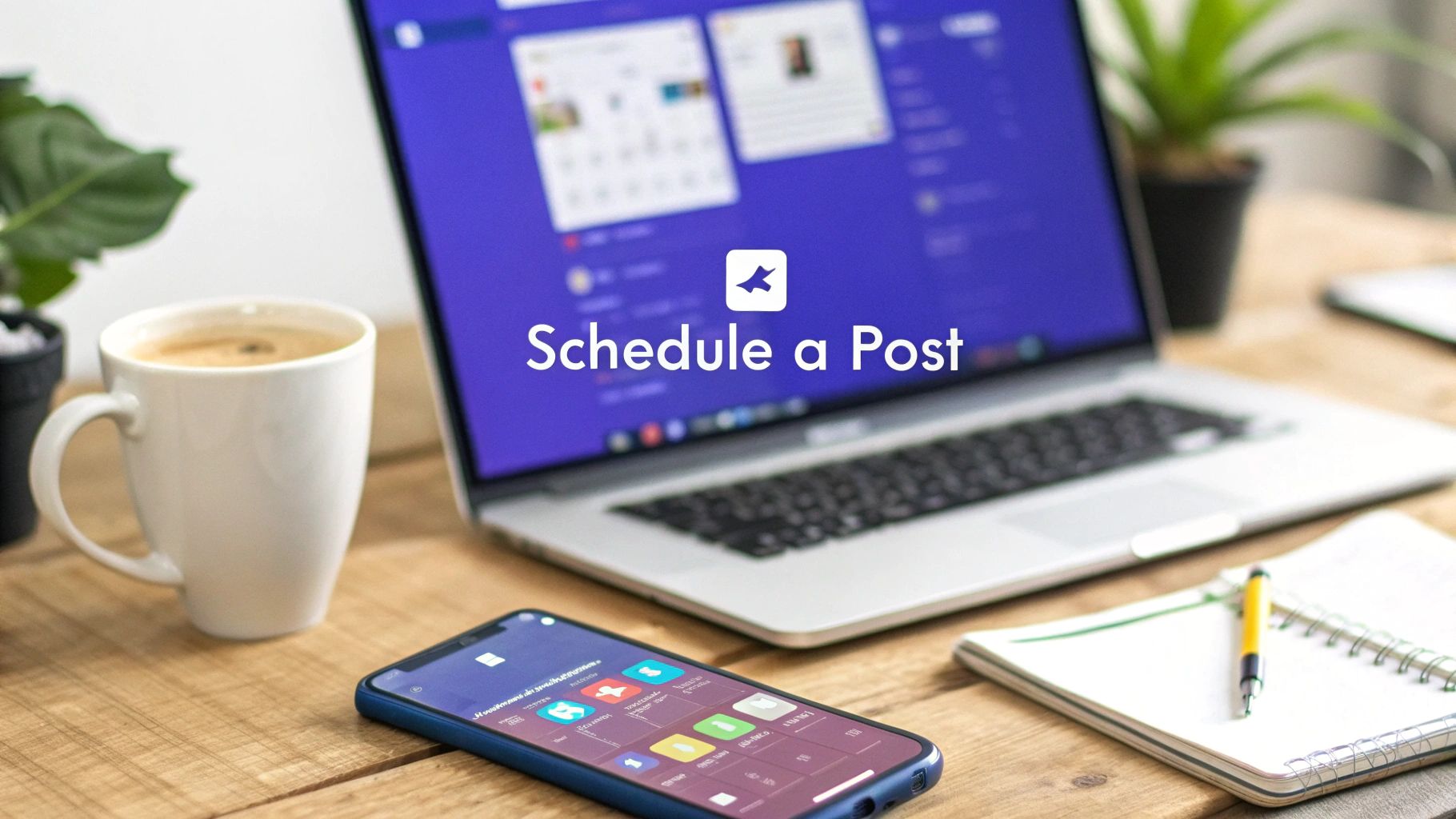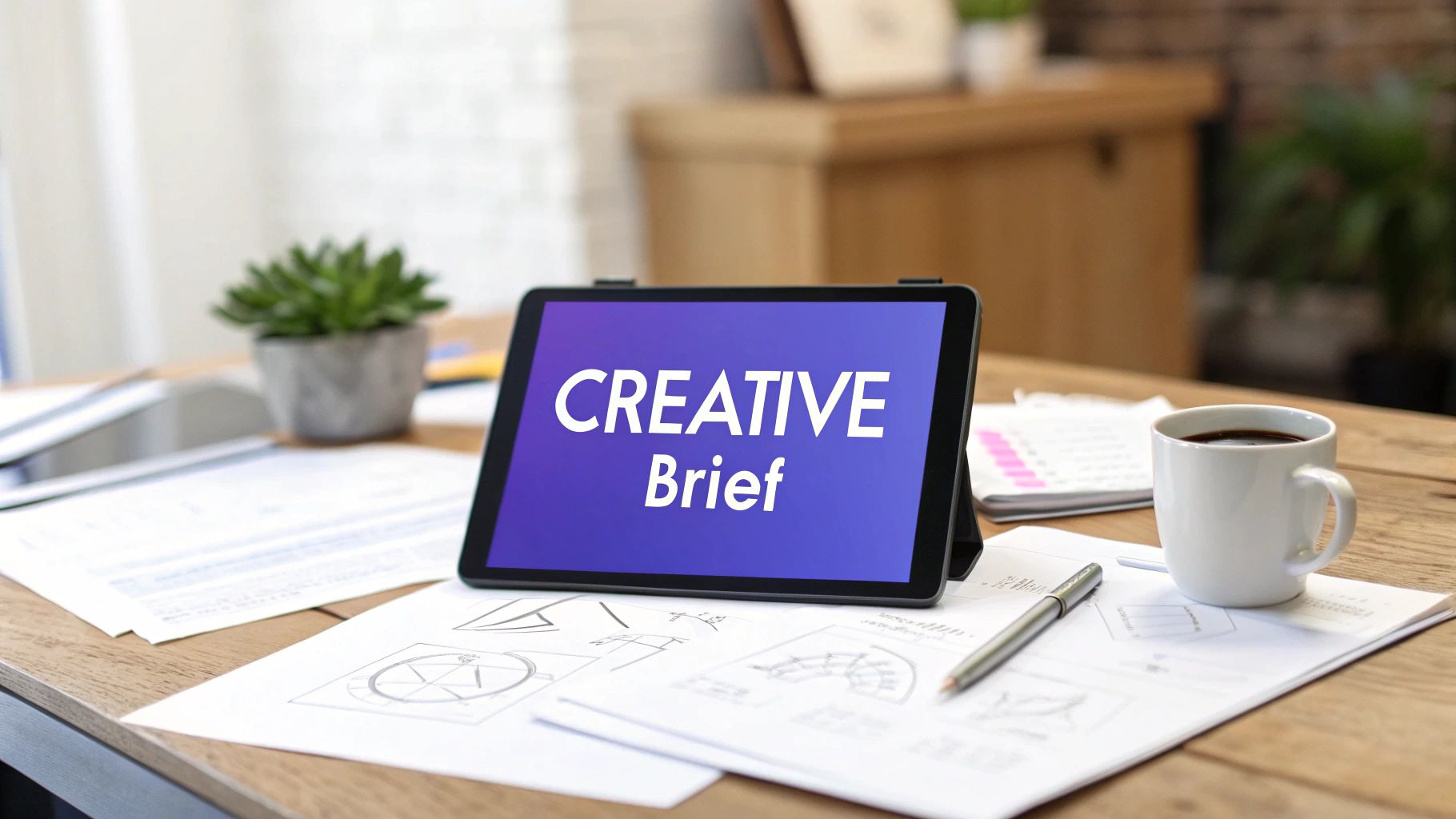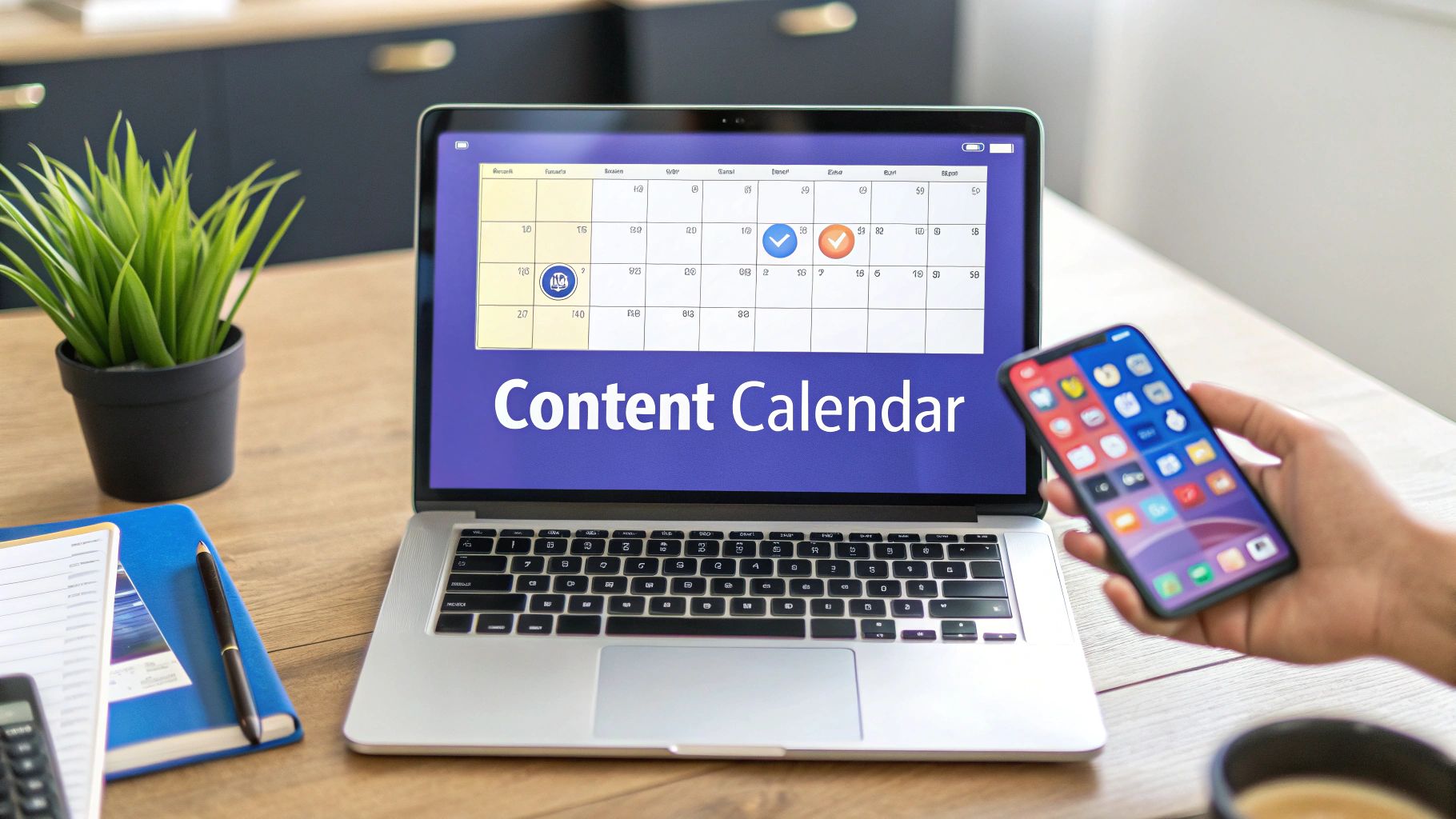To schedule a post, you need to use a social media management tool that lets you prepare content in advance and set a specific future date and time for it to publish automatically. This simple action is what turns your content workflow from reactive and chaotic to strategic and controlled, freeing up a massive amount of your time.
The Strategic Shift to Scheduled Content
Moving from posting on the fly to using a planned content calendar is one of the biggest leaps you can make for your brand. It’s the difference between constantly chasing the algorithm and actually commanding your online presence. When you schedule a post, you’re doing so much more than just saving a few minutes; you're building a reliable, consistent brand voice your audience can count on.
This proactive approach completely removes the daily pressure of figuring out what to share. Instead of that 9 AM scramble for an idea, you can sit down and batch-create a week's—or even a month's—worth of high-quality content in a single session. This headspace opens the door to more creativity and thoughtfulness, which leads to posts that are better researched, more polished, and perfectly aligned with your bigger marketing goals.
For a deeper dive into this process, check out our complete guide to social media scheduling.
From Chaos to Consistency
Let's look at a real-world example. Imagine a small e-commerce brand launching a new product line. A reactive strategy means frantically posting on launch day, just hoping to catch some attention.
A strategic, scheduled approach, on the other hand, looks completely different. It involves a planned series of posts:
- Teaser Content: Building excitement and anticipation a full week before the launch.
- Launch Day Blitz: A coordinated burst of posts across all platforms the very moment the product goes live.
- Follow-Up Posts: Sharing customer testimonials and user-generated content in the days that follow.
This methodical game plan turns a potentially chaotic event into a well-orchestrated campaign. It ensures your message reaches people across different time zones at the exact moments they're most likely to be online and engaged.
The real power of scheduling isn’t just about the automation. It’s about taking back control of your narrative. It allows you to tell a coherent story over time, rather than just shouting into the void whenever you have a spare minute.
Ultimately, scheduling your posts is an investment in predictability and quality. This shift lets you focus on the bigger picture—analyzing performance, actually engaging with your community, and planning your next big move—while your content calendar works diligently in the background, building your brand one post at a time.
Building Your Scheduling Foundation in PostSyncer
Any solid social media plan starts with a smart, organized setup. Before you start plugging posts into your content calendar, taking just a few minutes to build a proper foundation in PostSyncer will pay off big time. It turns a simple tool into a true command center for all your social media.

First things first, you'll need to connect your social media accounts. PostSyncer hooks directly into all the major players—Instagram, Facebook, LinkedIn, X, you name it. The process is dead simple, usually just an authentication window where you grant PostSyncer permission to publish for you. This creates a secure link between the platforms without you ever having to share your passwords directly.
Organizing Your Content for Sanity and Success
Once your profiles are all linked up, the real magic begins with creating content categories. Think of these as digital folders that bring some much-needed order to your strategy. This isn't just about being tidy; it's about gaining clarity. Organizing your posts this way makes it incredibly easy to see if you have a healthy mix of content going out.
From my experience, most brands benefit from categories like these:
- Product Launches: For all posts hyping up new features or items.
- Behind the Scenes: A great way to showcase your company culture and build a real community.
- Blog Content: Specifically for promoting your latest articles and driving traffic back to your site.
- User-Generated Content: A dedicated spot for curating and sharing posts from your biggest fans.
Getting this structure right from the get-go completely changes your scheduling workflow. Instead of staring at a chaotic list of upcoming posts, you get a bird's-eye view of your entire marketing plan. This ensures you're always maintaining a balanced and effective content mix.
This kind of organized approach is crucial whether you're scheduling a quick tweet or a full-blown blog post. While PostSyncer has your social scheduling covered, it's also smart to think about the bigger content picture. If you're publishing long-form content, check out these top website builders for blogs to find the perfect home for it. A solid foundation on both your scheduling tool and your publishing platform makes the whole process, from creation to publication, feel seamless.
Bringing Your Content Calendar to Life
Okay, you've connected your accounts and sorted your content into categories. Now for the fun part: turning that strategy into actual posts. This is where you’ll see your plan come together on PostSyncer's visual calendar. Think of the drag-and-drop interface as your command center—it’s where you’ll write copy, upload media, and tweak messages for each network.

Let's say you're launching a new app feature next week. Instead of frantically posting on the fly, you can map out the entire campaign ahead of time. Drag a slick teaser video to Monday to build hype. Then, drop a detailed carousel post on Wednesday that breaks down the benefits. To cap it all off, schedule a glowing customer testimonial for Friday to drive home the social proof.
This bird's-eye view is more than just good organization; it's a strategic edge. You can instantly see where the gaps are in your content plan and make sure you have a healthy mix of promotional posts and pure-value content. For a deeper dive into this kind of planning, our guide on building a powerful social media content calendar is a great resource.
Crafting Platform-Specific Posts
We’ve all seen it: the exact same message blasted across every social channel. It rarely works. A one-size-fits-all approach feels lazy because it is. PostSyncer gets this, which is why you can write a primary message and then easily customize it for each platform all from the same screen.
Sticking with our app feature launch, here’s how that might look in practice:
- LinkedIn: The copy would be professional and buttoned-up, focusing on how the new feature solves a critical business problem for your audience. No fluff.
- Instagram: Here, it’s all about the visuals. A snappy Reel with trending audio and a conversational, benefit-driven caption is the way to go.
- X (Twitter): You need to grab attention fast. A short, punchy tweet paired with a GIF showing the feature in action is perfect for the fast-scrolling feed.
This kind of customization isn't just a "nice-to-have" anymore. By 2025, smart content scheduling is all about balancing frequency with platform-native strategy. For example, many brands post to Instagram 3 to 5 times weekly, while a platform like X (Twitter) might demand up to 18 posts in that same timeframe to stay relevant. Understanding these nuances is everything.
When you can see your entire week or month on a single screen, you stop just filling slots. You start seeing the narrative of your brand unfold, making sure every single post works together to tell a cohesive story.
Let AI Optimize Your Posting Schedule
Stop guessing when your audience is most active. Seriously, trying to manually pinpoint the perfect time to post is a shot in the dark, and your content deserves better than that.
This is where you let data take the driver's seat. PostSyncer’s AI timing feature completely removes the guesswork by analyzing your unique audience engagement patterns. It’s the difference between a generic, one-size-fits-all approach and a precise, data-backed strategy that actually works.
The AI digs into your past performance on every social profile you've connected, identifying the specific windows when your followers are most likely to see and interact with your posts.
Imagine you have a huge announcement. Instead of just picking a time that feels right, the AI might suggest scheduling it for Instagram at 7 PM on Tuesday and on Facebook at 11 AM on Wednesday. Why? Because it knows that’s when each of those distinct audiences is scrolling, clicking, and ready to engage. This is how your most important content gets maximum visibility, every single time.
Before we dive into the nuts and bolts of scheduling, it's worth considering how AI can enhance creativity in the first place, helping you generate fresh ideas that resonate.
Putting AI Suggestions into Action
The best part? Applying these powerful insights is designed to be effortless.
When you go to schedule a post, PostSyncer will highlight its AI-recommended time slots right there on your calendar. You can accept these data-driven suggestions with a single click, taking all the manual labor and uncertainty out of optimization.
The market for these tools is definitely crowded, with a few major players taking up most of the space.

This chart shows that while established tools are popular, the real advantage now comes from intelligent features like AI-powered scheduling. It's the secret weapon that sets you apart.
Think of an AI scheduler as a dedicated data analyst for your social media. It constantly learns from your results and refines its recommendations, ensuring your strategy adapts and improves over time—without you having to lift a finger.
While PostSyncer’s AI gives you hyper-personalized timing, it’s still helpful to know the general best practices as a starting point. This combination of broad industry knowledge and specific AI analysis is what truly elevates your scheduling game.
I've put together a quick table to show you the recommended posting frequencies for major platforms versus what the average business actually does. It's a great way to benchmark your own efforts.
Platform Posting Frequency Guidelines
| Platform | Recommended Posts Per Week | Average Business Posts Per Week |
|---|---|---|
| 5-10 | 5.5 | |
| 3-7 | 4.5 | |
| X (Twitter) | 15-25 | 19.5 |
| 3-5 | 4.9 |
As you can see, the top-performing accounts are often more active than you might think. Don't be afraid to experiment with your own frequency and let the AI guide you to the sweet spot for timing.
Automating Your Best Content with Recurring Posts
Your top-performing content shouldn't just get a single day in the sun. Think about your cornerstone blog posts, killer case studies, or those core brand messages that always resonate. These are evergreen assets, and they should be working for you around the clock. This is where setting up recurring posts completely changes the game, turning your daily social media grind into a sustainable growth engine.

Instead of remembering to manually repost your greatest hits, you can build a recurring campaign right inside PostSyncer. It’s simple: you define how often you want a post to go out and for how long. This ensures your best stuff is always reaching new followers and staying top-of-mind, all without you lifting a finger.
Keeping Evergreen Content Fresh
Now, the secret to making recurring posts work is to not sound like a broken record. No one wants to see the exact same post every month. A simple tweak to the copy or a different visual can make old content feel brand new again. For a deeper dive on how this fits into a bigger plan, you should check out our guide on how to automate social media posts.
Here are a few of my go-to tactics for varying recurring content:
- Change the Hook: If you started with a statement last time, try asking a question or pulling out a surprising statistic to lead the caption.
- Swap the Visual: Did you share a static image before? Mix it up with a short video clip, a GIF, or even a customer testimonial graphic.
- Update the Call-to-Action: Frame the same link with a new prompt. Instead of "Read our guide," try "See the exact steps we took."
This move toward smart automation isn't just a hunch; it's a massive industry shift. The social media management market was valued at USD 17.5 billion in 2022 and is expected to rocket to USD 51.8 billion by 2027. That kind of growth tells you just how critical scheduling and automation have become for any serious marketer. You can find more data on social media scheduling trends from eclincher.com.
Imagine you have a fantastic e-book that generates leads. You could set up a campaign to share it every 45 days, but each time with a slightly different creative angle or a new customer quote. It's a true set-it-and-forget-it approach that keeps a steady stream of leads coming in while you're busy creating your next great piece of content.
Common Questions About Scheduling Social Media Posts
Even with the best tools, jumping into a new workflow always brings up a few questions. As you start scheduling your first few posts, you’ll likely run into some common "what ifs." Getting those answered right away helps you build a strategy that actually works instead of just guessing.
Let's dig into some of the questions I hear all the time from people who are just getting started with scheduling their social media.
Does Scheduling Posts Hurt My Engagement?
This is probably the biggest myth I see floating around, and it's time to put it to rest. The short answer is no—using a quality scheduler like PostSyncer does not hurt your engagement. Platforms like Instagram and Facebook have official partnerships (APIs) built specifically to work with approved tools.
The whole idea that platforms penalize scheduled content is a holdover from the early days of social media. Honestly, the opposite is usually true now. A good scheduler helps you post consistently and at the best possible times, which is something that’s nearly impossible to do manually. The algorithm rewards consistency and relevance, not how you clicked the "publish" button.
How Far in Advance Should I Schedule My Content?
Finding that sweet spot between planning ahead and staying flexible is crucial. For most brands I’ve worked with, scheduling content one to two weeks in advance is the perfect rhythm. It gives you a nice buffer to create thoughtful, polished posts without the last-minute scramble.
This timeframe also leaves you agile enough to hop on a trending topic or react to breaking news without derailing your entire content calendar. Of course, for bigger campaigns like a product launch or a holiday promotion, planning a month or more ahead is completely normal. The goal is to be organized, not so rigid that you can't adapt.
Don't confuse planning with being inflexible. A well-managed content calendar is a living document. It provides structure but should always have room for spontaneity and strategic pivots when needed.
What Is the Difference Between Scheduling and a Queue?
This is a great question, and knowing the difference is a huge advantage. These two features solve different problems.
When you schedule a post, you're locking it in for a specific date and time. It's all about precision. This is perfect for time-sensitive content like:
- Announcing a flash sale that kicks off at exactly 9 AM.
- Coordinating a product launch across multiple time zones.
- Sharing a holiday greeting right on the day.
A content queue, on the other hand, is your library of pre-approved, evergreen posts. You set up recurring time slots (say, every Monday and Friday at 2 PM), and the tool automatically grabs the next post from your queue to fill the spot. Queues are fantastic for keeping a steady stream of content flowing and filling the gaps with valuable, non-urgent posts like blog articles, tips, or behind-the-scenes content.
Can I Edit a Post After I Schedule It?
Of course. Any scheduler worth its salt will let you easily edit, reschedule, or even delete a post right up until the moment it goes live. This flexibility isn't just a nice-to-have; it's essential.
If you spot a last-minute typo or your strategy suddenly shifts, you can just hop back into your calendar, find the post, and make your changes. Whether you need to tweak the copy, swap an image, or move it to a different day entirely, you always have full control over what your audience sees.
Ready to stop guessing and start scheduling with data-driven precision? PostSyncer gives you the AI-powered tools and intuitive calendar you need to take control of your social media. Start your free 7-day trial today and see the difference.















